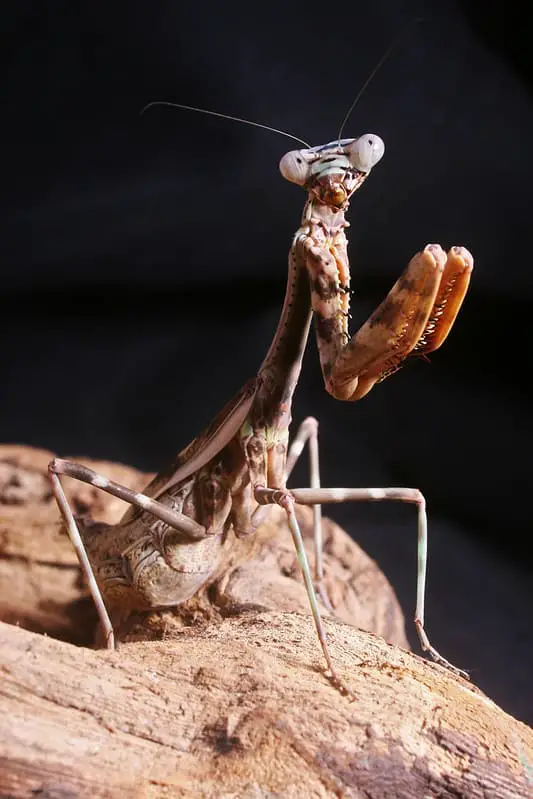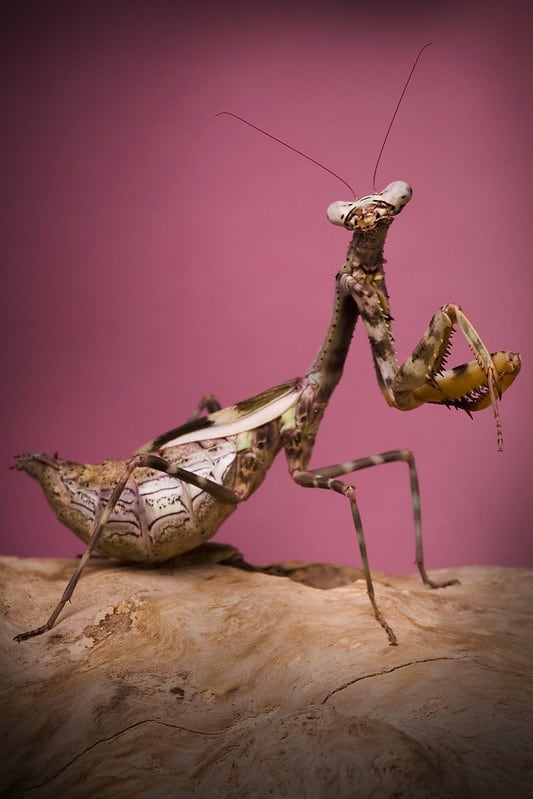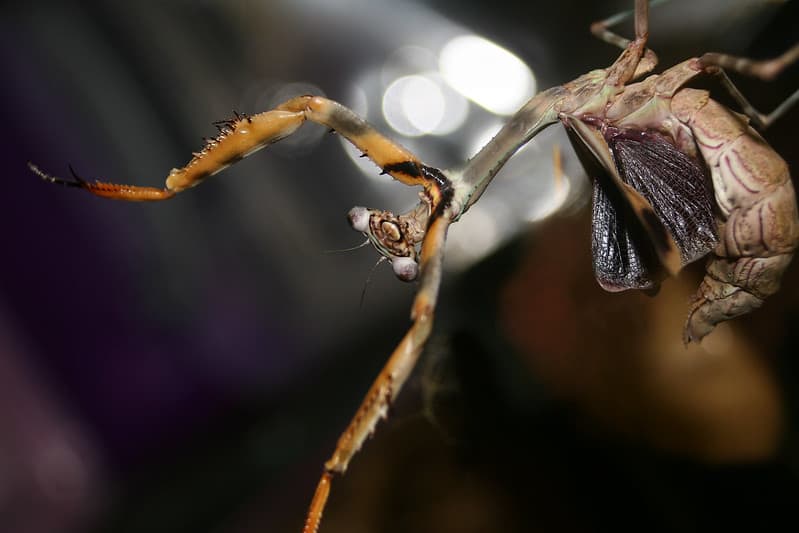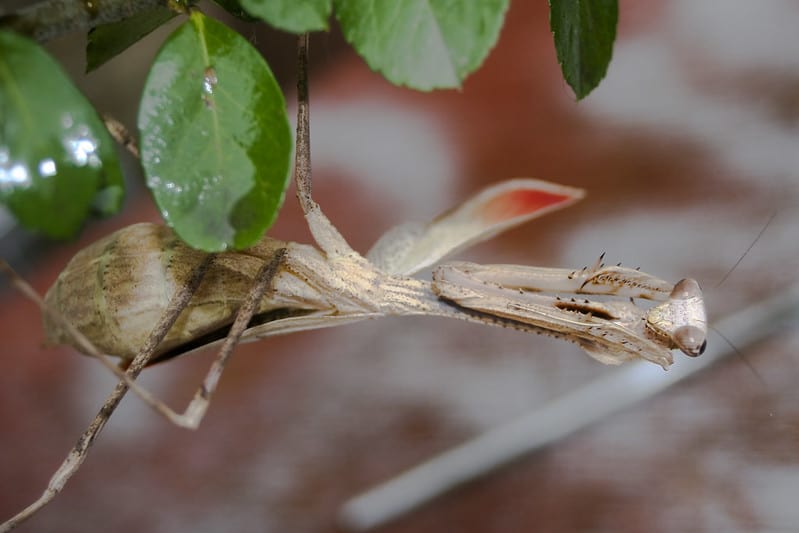The Budwing Mantis (Parasphendale affinis) is a beautiful and popular mantis species native to East Africa. It’s famous for its voracious appetite and aggressive behavior; it’s also known for the tiny bud-shaped wings in adult females which give them a very distinct and recognizable appearance.
If you’re thinking about adding the fantastic Budwing Mantis to your collection, this article has everything you need to know to properly care for this interesting species.

Budwing Mantis Care Sheet
| Name of species | Parasphendale affinis |
| Family | Mantidae |
| Common name | Budwing Mantis |
| Type | Brachypterous |
| Native location | East Africa |
| Temperature | 72°F to 86°F |
| Humidity | 40% to 60% |
| Size | 1.2 to 2.8 inches (3 to 7 cm) |
| Diet | Small insects |
| Lifespan | Females: 18 months / Males: 6 months |
| Experience level | Beginner |
Budwing Mantis Overview
The Parasphendale affinis is known in the insect-keeping hobby as the Budwing Mantis, thanks to its small wings.
This species is found in East Africa, specifically in Ethiopia, Somalia, and in Kenya. Its short wings make it a brachypterous mantis, but it doesn’t mean that they cannot fly.
They’ll eat any flying and crawling insects that are small enough for them to catch, so they’re easy to feed.
Appearance & Variations

The most characteristic trait of the Budwing Mantis is only displayed in the female specimens. Adult males have wings that go slightly over their abdomen, but females have bud wings that reach half the abdomen, making them unable to fly.
However, they don’t need to fly, as their bold and tough behavior is their answer to predators. They present different tonalities of gray, brown, and green but are mottled all over with darker tones reaching black.
Their forearms have brighter colors that they display right next to their pink eyes when they’re in a threat posture; this allows them to look like larger animals and fend off predators.
As for size, male Budwing Mantises are much smaller than females. Males top out at a size of around 1.2 inches whereas females can grow to a size of up to 2.8 inches.
Price
This amazing mantis is very sought after in this hobby, driving its price slightly up even though it’s not so difficult to find.
Nymphs can be bought for around $35, while adults can rise to $45 in costs. In the case of the Budwing Mantis, the nymphs are known for being durable and having high survivability, so it’s ideal to start there even for the most inexperienced hobbyists.
Not only are the nymphs cheaper and easy to raise, but you’ll get to experience the full life cycle of the animal which gives you valuable experience if you want to move on to more difficult mantis species.
Behavior and Temperament

The Budwing Mantis is a voracious mantis that will eat until harming itself it there’s enough food available.
They’re active hunters that will chase their prey, an uncommon trait among mantids, which are mostly ambush hunters. They also have a dramatic threat posture that she’ll show if you try to grab it, a big display of its defensive nature.
Males have a tendency to get scared and fly away from fights, but females usually stay their ground with their wide threat posture.
As is the case with most mantids, the Budgwing Mantis will prey on each other if given a chance; so you should have more than one specimen in the same enclosure unless you’re trying to breed them.
Caring for a Budwing Mantis

Temperature and Humidity
The BM is used to a hot and slightly dry climate, so the ideal temperature lies between 72°F and 86°F. You can allow the temperature to drop to around 65°F during the night, so its environmental requirements aren’t demanding.
Regarding the humidity, you should maintain it between 40% and 60% to keep it comfortable; going below that may give your BM trouble during molts, which is dangerous as it may harm itself in the process.
Substrate
Your Budwing Mantis should have at least one inch of substrate, but no more than that is needed because they don’t burrow. It should be a dry substrate, so mixtures with sand, coconut fiber, gravel, and soil are ideal.
Tank
The BM needs more space than most mantids because of their active behavior. They need room to chase after their prey, so you shouldn’t keep them in an enclosure with under three gallons of volume.
Remember to keep these mantids alone since they’ll prey on each other if you keep more than one in the same enclosure.
Twigs and branches are a necessary decoration to allow the mantis to molt, and fake plants and foliage are welcome additions to the enclosure.
Finally, the BM is used to a windy climate, so make sure there are enough ventilation holes in the tank’s walls.
Watering
The Budwing Mantis isn’t so reliant on humidity as most other mantids. You should mist the enclosure once every three days to maintain the ideal humidity level and provide the BM with droplets to drink.
It’ll get its hydration by drinking these drops and feeding on its prey, so placing a water dish in the tank is unnecessary.
Communal living
The Budwing Mantis is an aggressive species. In the wild, they live solitarily and only meet other members of their species when it’s time to mate. Cannibalism is common in this species, so you should never house more than one of them in the same enclosure.
If you’re interested in keeping a communal mantis setup, make sure to use a species that’s capable of it like the Ghost Mantis or the Devil’s Flower Mantis. Trying a communal setup with non-compatible species will just end in cannibalism.
Health & Lifespan
The Budwing Mantis is a hardy, strong species. They can easily reach a lifespan of 18 months for females, but males usually live much shorter at about 6 months.
In captivity, it’s not hard for them to reach their full lifespan as long as you ensure that their enclosure is well suited for them and that you feed them high-quality food.
The most important things you need to do to keep your mantis healthy are making sure that uneaten food is removed in a timely manner and making sure that they have enough ventilation to prevent the growth of mold. Furthermore, the feeder insects you offer them should be captive-bred rather than wild-caught as wild-caught insects frequently contain parasites.
Also, if you plan on handling your mantis, do so carefully. The insect cannot harm you, but you can very easily harm it, even on accident.
Diet of a Budwing Mantis
When planning a Budwing Mantis’ diet, you must consider their voracious behavior. If given enough food, they’ll eat until they’re sick, so you must be extra careful not to overfeed these mantids.
Their food consumption and what they should eat depend highly on their stage of development.
- L1 and L2 nymphs should eat small fruit flies
- L3 to L5 can feed on big fruit flies or greenbottle flies
- L6 nymphs have a wider range of prey they can feed on up to adulthood. They’ll eat anything they can catch, and you should use this to feed them with a varied diet of flies, moths, worms, crickets, and roaches
Be careful not to give them venomous food or food that exceeds ⅓ of its size, or it may turn out badly for the mantis.
Feed it every couple of days and be mindful of its abdomen; if you notice it getting bigger and bulkier, adjust its diet to keep it from getting sick.
Fun Facts about the Budwing Mantis
- The Parasphendale genus has two mantids used as pets, the P. affinis, which is the subject of this article, and the P. argrionina. Since both species are so similar that they’re difficult to tell apart, the information presented here applies to either of these two beautiful species.
- Male and female specimens of this species have small wings, but the female has them even smaller. Their shape is also slightly similar to that of a bud, which is the reason why they have that name. Since their wings are so small, they are incapable of flight.
- While most mantids rely entirely on their camouflage and ambushing their prey, a Budwing Mantis likes to give chase. Instead of just waiting for its prey to get close, the mantis will go after it as soon as it sees it, which makes for an exciting display for hobbyists.
Final words
The Budwing Mantis is a fun and exciting mantis you should consider adding to your collection. It’s beautiful, feisty, and voracious, all traits of a great pet insect; it’s also a great entry point as nymphs are almost as durable as adult specimens.
Even if you’re not new to keeping mantids as pets, the Budwing Mantis is an interesting species with lots to offer even to experienced keepers.
Nevertheless, if after reading this you’re not convinced that this is the right species for you, you might be interested in checking out the Carolina Mantis or the Spiny Flower Mantis instead!
- How Long Do American Eskimo Dogs Live? Important Factors and Care Tips - September 29, 2023
- Do American Bulldogs Need Grooming? Essential Tips and Care Guidelines - September 29, 2023
- Do Bengal Cats Enjoy Playing? Essential Tips for Keeping Them Active - September 29, 2023